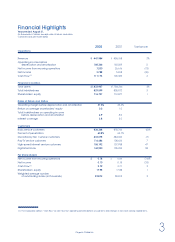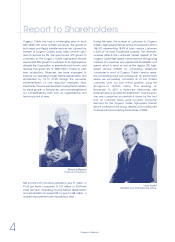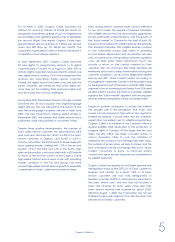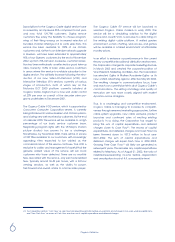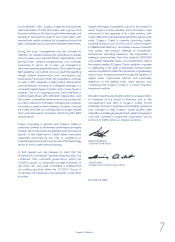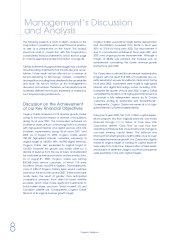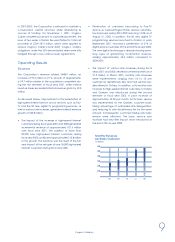Cogeco 2002 Annual Report Download - page 14
Download and view the complete annual report
Please find page 14 of the 2002 Cogeco annual report below. You can navigate through the pages in the report by either clicking on the pages listed below, or by using the keyword search tool below to find specific information within the annual report.
13
Cogeco Cable Inc.
Capital Expenditures
(in millions of dollars)
2001 2002 2003
Actual Actual Forecast
System modernization,
extension and fiber optic $ 67 40% $ 57 47% $ 47 44%
High-speed Internet and
digital technology 38 23 20 16 26 24
Maintenance and other 61 37 45 37 34 32
To t a l $1 6 6 1 0 0% $ 1 2 2 1 0 0 % $ 1 0 7 1 0 0 %
Cable System Acquisitions
During fiscal year 2002, Cogeco Cable did not acquire
any cable systems. In fiscal year 2001, Cogeco Cable
completed the acquisition of cable systems serving
approximately 73,700 basic service customers in Ontario
and 30,100 basic service customers in Quebec. The total
purchase price for cable system acquisitions completed
during 2000–2001 amounted to $226.1 million, and was
financed by cash payments totaling $80.9 million as well
as the issue of approximately 3.8 million subordinate
voting shares.
Capital Ex p e n d i t u res and
D e f e r red Charge s
The annual capital expenditure program decreased
from $166.4 million in 2000–2001 to $122.1 million in 2001–
2002. The table below presents a summary of capital
expenditures for the past two fiscal years, and the fore-
cast for 2002–2003.
The 2002 capital expenditures plan focused mainly on
completing the two-way broadband upgrade of the
network, as well as extending digital technology to the
remaining Quebec regions. As of August 31, 2002, 86% of
Cogeco Cable’s total homes passed had access to
high-speed Internet, and digital services were offered to
close to 95% of homes passed.
Increase in deferred charges went from $1.5 million in
fiscal year 2001 to $28.0 million in fiscal year 2002.
$20.3 million of this increase relates to subsidies on sales
of 71,233 digital terminals, and other costs incurred in
order to expand customer base. The balance relates to
costs from the issuance of two Senior Secured Notes,
from the amendment to the Term Facility and from the
introduction of new digital services.
F i n a n c i n g
On November 1, 2001, Cogeco Cable completed, pur-
suant to a private placement, the issue of 6.83% Series A
Senior Secured Notes for US $150 million maturing October
31, 2008, and 7.73% Series B Senior Secured Notes for CDN
$175 million maturing October 31, 2011. In addition,
Cogeco Cable completed cro s s - c u r r ency swap agre e-
ments to fully hedge its financial obligations with re s p e c t
to the US denominated Series A Senior Secured Notes.
Taking into consideration the cro s s - c u r rency swap agre e-
ments, the interest rate effectively incurred by Cogeco
Cable for the Series A Senior Secured Notes is 7.254%. Net
p roceeds of CDN $410 million, after underwriters’ fees and
other expenses, were applied to reduce Cogeco Cable’s
bank debt.
At its request and in light of the successful completion of
the private placement mentioned above, Cogeco
Cable amended its Te rm Facility during the fourth
quarter of fiscal year 2002. The changes resulted in a
reduction of the total commitment from $585 million to
$400 million. The amendment also provides the Corpo-
ration with more financial flexibility, while the maturity of
the facility and future reduction of commitment levels
remain unchanged.
No dividend was paid during fiscal year 2002. In the first
quarter of fiscal year 2001, the Corporation paid a
dividend of $0.03 per share and no dividend was paid
t h e re a f t e r. This revised dividend policy reflected more
d i fficult than expected competitive conditions and the
Corporation’s need to focus more of its available cash flow
on investments in system upgrades and new technologies.


